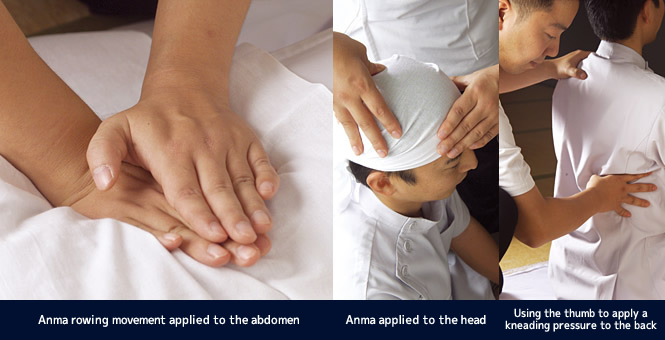Anma, Massage, and Shiatsu
Anma, Massage, and Shiatsu
Anma, massage, and shiatsu are all similar in that each uses the hands and fingers to provide treatments. However, there are differences.
Anma originated in China and then was introduced to Japan. Due to its origins, anma is based on the tenets of oriental medicine. Anma utilizes acupoints and meridians for treatments that are provided through a thin layer of clothing. Treatments in anma generally progress from the center of the body out to the extremities.
Massage originated in Europe, subsequently being introduced to Japan during the Meiji period. Massage does not utilize acupoints or meridians; instead it is based on the circulatory systems of blood and lymphatic fluids. Massage treatments are applied directly to the skin, utilizing oil or other lubricants. Opposite to anma, massage treatments start in the extremities and progress to the center of the body.
Shiatsu developed out of classical anma, Taoist breathing exercises, and Judo healing techniques. Furthermore, shiatsu incorporated the theory and techniques of various early twentieth century American bodywork and manipulative arts. Shiatsu is generally applied through clothing, utilizing single points of pressure moving from the center of the body outward to the extremities.

Practicing touch on a living person is incredibly important to and indispensable for the study of acupuncture and moxibustion. It is for this reason that we emphasize manual therapies at the Toyoshinkyu College of Oriental Medicine, especially a type of anma called “suji-momi” which is deeply connected to acupuncture and moxibustion. There is an incredible diversity of manual therapies being practiced today. Despite this, anma was the main form of treatment in the past, treatment that primarily utilized acupoints and meridians while being performed as one field of oriental medicine. “Suji-momi” is based on these theories and is a form of manual treatment that has a long history in Japan. Of course, it is only natural to study acupoints and meridians using living human bodies. However, this study is not simply aimlessly touching, instead, there is a codified method. That method is “suji-momi” anma. At the Toyoshinkyu College of Oriental Medicine we want our students to become clinical practitioners who practice acupuncture and moxibustion as oriental medicine. In order to achieve this objective we are exacting about the implementation of manual therapies.


